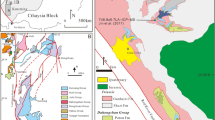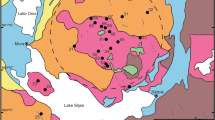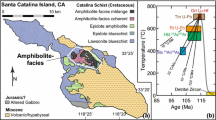Abstract
The Santa Rosa mylonite zone developed predominantly from a granodiorite protolith in the eastern margin of the Peninsular Ranges batholith. A wide variation in K−Ar biotite dates within the zone is shown to reflect the times of cooling through closure temperatures whose variability is chiefly a result of deformation-induced reduction in grain size. We suggest that such variation generally may be exploited to place constraints on the timing of deformation episodes. Previous workers have shown that deformation in the Santa Rosa mylonite zone involved the formation of mylonites and an imbricate series of low-angle faults which divide the area into structural units. Field work, petrographic studies, and TEM analysis of deformation mechanisms in biotite show that the granodiorite mylonite, the lowermost structural unit, formed below the granodiorite solidus. The granodiorite mylonite varies from protomylonite to ultramylonite, with regions of high strain distributed heterogeneously within the zone. Previously reported biotite and hornblende K−Ar dates from the granodiorite protolith below (82–89 Ma) and the Asbestos Mountain granodiorite above (61–68 Ma) the mylonite zone indicate dramatically dissimilar thermal histories for the lowermost and uppermost structural units. Other workers' fission track dates on sphene, zircon, and apatite from the granodiorite mylonite and the Asbestos Mountain granodiorite suggest thermal homogenization and rapid cooling to ∼100° C by ca 60 Ma. Within and adjacent to the mylonite zone, K−Ar dates on 5 samples of biotite from variably deformed granodiorite range from 62–76 Ma; dates are not correlated with structural depth but clearly decrease with degree of deformation and concomitant grain size reduction. 40Ar/39Ar incremental heating analyses of biotite from the granodiorite protolith reveals no evidence of excess argon and produces a relatively flat age spectrum. 40Ar/39Ar incremental heating analysis of biotite from the granodiorite mylonite discloses discordance consistent with 39Ar recoil loss. K analysis of samples, allowing K−Ar dates to be calculated, is therefore recommended as an adjunct to 40Ar/39Ar step heating analysis in rocks that have experienced similar deformation. During mylonitization, biotite grain size reduction through intracrystalline cataclasis results in estimated grain dimensions as small as 0.05 μm locally within porphyroclasts as large as 1 mm. Because biotite compositions are relatively Uniform (Fe/[Fe+Mg+Mn+Ti+AlVI]=0.47–0.52) and show no systematic variation with grain size, compositional dependence of activation energy and diffusivity can be eliminated as sources of variation in Ar retention. Ar closure temperatures, calculated with appropriate diffusion parameters for the observed grain sizes, are in the range ∼220–280° C and define a cooling curve consistent with a thermal history intermediate between those of the granodiorite protolith below and the Asbestos Mountain granodiorite above the mylonite zone. Changes in the slope of the cooling curve indicate that the main deformation episode initiated at or above ca 330° C (∼80 Ma), above the closure temperature for thermally activated diffusion of argon in biotite, and continued to a minimum of ca 220–260° C (∼62 Ma).
Similar content being viewed by others
References
Ague, DM (1987) Natural deformation of plagioclase: A microstructural investigation. PhD Thesis University of California, Berkeley, USA
Ague JJ, Brimhall GH (1988) Magmatic are asymmetry and distribution of anomalous plutonic belts in the batholiths of California: effects of assimilation, cratonal thickness, and depth of crystallization. Bull Geol Soc Am 100:912–927
Ahn JH, Peacor DR, Essene EJ (1985) Cocxisting paragonite-phengite in blueschist eclogite: a TEM study. Am Mineral 70:1193–1204
Armstrong RL, Suppe J (1973) Potassium-argon geochronometry of Mesozoic igneous rocks in Nevada, Utah and southern California. Bull Geol Soc Am 84:1375–1392
Brodie KH, Rex D, Rutter EH (1989) On the age of extensional faulting in the Ivrea zone, northern Italy. In: Coward MP, Dietrich D, Park RG (eds) Alpine tectonics. Geol Soc Special Pub: 203–210
Calk LC, Naeser CW (1973) The thermal effect of a basalt intrusion on fission tracks in quartz monzonite. J Geol 81:189–198
Coney PJ, Reynolds SJ (1977) Cordilleran Benioff zones. Nature 270:403–405
Dalrymple GB, Lanphere MA (1969) Potassium-argon dating —principles, techniques and applications to geochronology. WH Freeman Co, San Francisco, USA
Dalrymple GB, Alexander EC, Lanphere MA, Kraker GP (1981) Irradiation of samples for 40Ar/39Ar dating using the Geological Survey TRIGA reactor. US Geol Surv Prof Pap 1176
Dickinson WR, Snyder WS (1978) Plate tectonics of the Laramide orogeny. Mem Geol Soc Am 151:355–366
Dodson MH (1973) Closure temperature in cooling geochronological and petrological systems. Contrib Mineral Petrol 40:259–274
Dokka RK (1984) Fission-track geochronologic evidence for Late Cretaceous mylonitization and early Paleocene uplift of the northeastern Peninsular Ranges, California. Geophy Res Lett 11:46–49
Dokka RK, Frost EG (1978) Fission-track ages from the Santa Rosa mylonite zone and its protolith and their relation to the cooling history of the southern California Batholith. Geol Soc Am Abstr with Progr 10:103
Erskine BG (1985) Mylonitic deformation and associated low-angle faulting in the Santa Rosa mylonite zone, southern California. PhD Thesis University of California, Berkeley, USA
Erskine BG (1986) Metamorphic and deformation history of the eastern Peninsular Ranges mylonite zone: implications on tectoic reconstructions of southern California. Geol Soc Am Abstr with Prog 18:105
Erskine BG, Wenk, H-R (1985) Evidence for late Cretaceous crustal thinning in the Santa Rosa mylonite zone, southern California. Geol 13:274–277
Giletti BJ (1974) Studies in diffusion I: argon in phlogopite mica. In: Hofmann AW, Giletti BJ, Yoder HS Jr, Yund RA (eds) Geochemical transport and kinetics. Carnegie Inst Wash Publ 634:107–115
Gleadow AJW, Brooks CK (1979) Fission track dating, thermal histories and tectonics of igneous intrusions in East Greenland. Contrib Mineral Petrol 71:45–60
Goodwin LB (1988) Structural studies of two strongly deformed terranes in California and Arizona. PhD Thesis University of California, Berkeley, USA
Goodwin LB, Wenk H-R (1990) Intracrystalline folding and cataclasis in biotite of the Santa Rosa mylonite zone: HVEM and TEM Observations. Tectonophysics 172:201–214
Hammarstrom JM, Zen E-A (1986) Aluminum in hornblende: an empirical geobarometer. Am Mineral 71:1297–1313
Harrison TM (1981) Diffusion of 40Ar in hornblende. Contrib Mineral Petrol 78:324–331
Harrison TM, Armstrong RL, Naeser CW, Harakal JE (1979) Geochronology and thermal history of the Coast Plutonic complex, near Prince Rupert, BC. Can J Earth Sci 16:400–410
Harrison TM, Duncan I, McDougall I (1985) Diffusion of 40Ar in biotite. Temperature, pressure and compositional effects. Geochim Cosmochim Acta 49:2461–2468
Harrison TM, Fitz Gerald JG (1986) Exsolution in hornblende and its consequences for 40Ar/39Ar age spectra and closure temperatures. Geochim Cosmochim Acta 50:247–253
Hill RI, Silver LT (1979) Strontium isotopic variability in the pluton of San Jacinto Peak, southern California. EOS, Trans Am Geophys Union 61:411
Itaya T, Takasugi H (1988) Muscovite K−Ar ages of the Sanbagawa schists, Japan and argon depletion during cooling and deformation. Contrib Mineral Petrol 100:281–290
Jones KA, Galwey AK (1972) Variation of the length/thickness ratio of biotite crystals in metamorphic rocks. J Geol 80:112–120
Kelley S (1988) The relationship between K−Ar mineral ages, mica grain sizes and movement on the Moine Thrust Zone, NW Highlands, Scotland. J Geol Soc London 145:1–10
Keith SB (1978) Paleosubduction geometries inferred from Cretaceous and Tertiary magmatic patterns in southwestern United States. Geology 6:516–521
Kirby SH (1985) Rock mechanics observations pertinent to the rheology of the continental lithosphere and the localization of strain along shear zones. Tectonophysics 119:1–27
Kligfield R, Hunziker J, Dallmeyer RD, Schmael S (1986) Dating of deformation phases using K−Ar and 40Ar/39Ar techniques: results from the northern Appenines. J Struc Geol 8:781–798
Knopf EB (1931) Retrogessive metamorphism and phyllonitization. Am J Sci 21:1–27
Krummenacher D, Gastil RG, Bushee J, Doupont J (1975) K−Ar apparent ages, Peninsular Ranges batholith, southern California and Baja California. Bull Geol Soc Am 86:760–768
Lee JKL, Onstott TC, Hanes JA (1989) An 40Ar/39Ar investigation of the contact effects of a dyke intrusion, Kapuskasing structural zonc, Ontario. Contrib Mineral Petrol 105:87–105
Lo C-H, Onstott TC (1989) 39Ar recoil artifacts in chloritized biotite. Geochim Cosmochim Acta 53:2697–2711
Lovera OM, Richter FM, Harrison TM (1989) The 40Ar/39Ar thermochronometry for slowly cooled samples having a distribution of diffusion domain sites. J Geophys Res 94:17917–17935
May DJ, Walker NW (1989) Late Cretaceous juxtaposition of metamorphic terranes in the southeastern San Gabriel Mountains, California. Bull Geol Soc Am 101:1246–1267
McDougall I, Harrison TM (1988) Geochronology and thermochronology by the 40Ar/39Ar method. Oxford Univ Press, 212 pp
Naeser CW, Faul H (1969) Fission-track annealing in apatite and sphene. J Geophys Res 74:705–710
O'Brien DK (1985) Strain estimation and sense-of-shear determination in phyllonites and ultramylonites based on phyllosilicate preferred orientation. MS Thesis University of California, Berkeley, USA
O'Brien DK, Wenk H-R, Ratschbacher L, You Z (1987) Preferred orientation of phyllosilicates in phyllonites and ultramylonites. J Struc Geol 9:719–730
Onstott TC, Peacock SM (1987) Argon retentivity of hornblendes: a field experiment in a slowly cooled metamorphic terrane. Geochim Cosmochim Acta 51:2891–2903
Onstott TC, Pringle-Goodell L (1988) The influence of microstructures on the relationship between argon retentivity and chemical composition of hornblende. Geochim Cosmochim Acta 52:2167–2168
Onstott TC, Phillips D, Pringle-Goodell L (1991) Laser microprobe measurement of chlorine and argon zonation in hydrosilicates. Chem Geol (in press)
Peacock SM (1989) Thermal modeling of metamorphic pressure-temperature-time paths: A forward approach. In: Spear FS, Peacock SM, Metamorphic pressure-temperature-time paths. Short Course Notes, 28th Int Geol Cong, Washington, DC, July 9–19, 1989. Am Geophys Union
Phillips D, Onstott TC (1989) Argon isotopic zoning in mantle phlogoitc. Geology 16:542–546
Roddick JC, Cliff RA, Rex DC (1980) The evolution of excess argon in alpine biotites-A 40Ar/39Ar analysis. Earth Planet Sci Lett 48:185–208
Sharp RV (1979) Some characteristics of the eastern Peninsular Ranges mylonite zone. In: Proceedings, Conference VIII, Analysis of actual fault zones in bedrock. US Geol Surv Open-File Rept 79-1239:258–267
Sibson RH (1986) Earthquakes and rock deformation in crustal fault zones. Ann Rev Earth Planet Sci 14:149–175
Sibson RH (1977) Fault rocks and fault mechanisms. J Geol Soc London 133:191–213
Silver LT, Taylor HP, Chappell B (1979) Some petrological, geochemical and geochronological observations of the Peninsular Ranges batholith near the international border of the USA and Mexico. In: Abbott PL, Todd VR (eds) Mesozoic crystalline rocks. San Diego State Univ, Dept of Geological Sciences, Guidebook for Geol Soc Am Annual Meeting, San Diego, CA: 83–110
Simpson C (1984) Borrego Springs-Santa Rosa mylonite zone: a Late Cretaceous west-directed thrust in southern California. Geol 12:8–11
Simpson C (1985) Deformation of granitic rocks across the ductilebrittle transition. J Struc Geol 7:503–511
Snyder WS, Dickinson WR, Silberman ML (1976) Tectonic implications of space-time patterns of Cenozoic volcanism in the western United States. Earth Planet Sci Lett 32:91–106
Steiger and Jager (1977) Subcommission on geochronology: convention on the use of decay constants in geo- and cosmochemistry. Earth Planet Sci Lett 36:359–362
Theodore TG (1970) Petrogenesis of mylonites of high metamorphic grade in the Peninsular Ranges of southern California. Bull Geol Soc Am 81:435–450
Todd VR, Erskine BG, Morton DM (1988) Metamorphic and tectonic evolution of the northern Peninsular Ranges batholith, southern California. In: Ernst WG (ed) Metamorphism and crustal evolution of the western United States. Rubey Vol. 7, Prentice-Hall, Englewood Cliffs, NJ, pp 894–937
Tullis J, Snoke AW, Todd VR (1982) Significance and petrogenesis of mylonitic rocks. Penrose Conference Report. Geol 10:227–230
Turner G, Cadogan PH (1974) Possible effects of 39Ar recoil in 40Ar−39Ar dating. Proc Lunar Sci Conf 5th:1601–1615
Wallace RD, English DJ (1982) Evaluation of possible detachment faulting west of the San Andreas, Southern Santa Rosa Mountains, California. In: Frost EG, Martin DL (eds) Mesozoic-Cenozoic tectonic evolution of the Colorado River Region, California, Arizona, and Nevada, Cordilleran Publ, San Diego, CA, USA pp 502–509
Wenk H-R, Pannetier J (1990) Texture development in deformed granodiorites from the Sauta Rosa mylonite zone. J Struct Geol 12:177–184
Zeitler PK, Fitz Gerald JD (1986) Saddle-shaped 40Ar/39Ar age spectra from young, microstructurally complex potassium feldspars. Geochim Cosmochim Acta 50:1185–1199
Zimmerman RA (1977) The interpretation of apatite fission track ages with an application to the study of uplift since the Cretaceous in castern North America. PhD Thesis University of Philadelphia, USA
Author information
Authors and Affiliations
Rights and permissions
About this article
Cite this article
Goodwin, L.B., Renne, P.R. Effects of progressive mylonitization on Ar retention in biotites from the Santa Rosa mylonite zone, California, and thermochronologic implications. Contr. Mineral. and Petrol. 108, 283–297 (1991). https://doi.org/10.1007/BF00285937
Received:
Accepted:
Issue Date:
DOI: https://doi.org/10.1007/BF00285937




